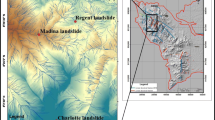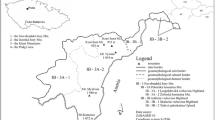Abstract
Rila Mountain in Southwest Bulgaria is the highest mountain on the Balkan Peninsula. During the Pleistocene ice ages, large ice shields covered higher parts of the mountain forming cirques and through glacier valleys. Maritsa Cirque Complex is the through head of one of the most powerful glaciers, carved out in the mountain. Since it was nominated for a geosite of esthetic and scientific value within Geopark Rila, in order to improve, precise, and unify the method of characterization and presentation of geomorphosites in alpine environment, it was chosen as an example description to serve as a model for characterization of the other geomorphosites in the geopark. Maritsa Cirque Complex is well outlined in its natural boundaries on an area of 5.29 km2 including five composite cirques: Maritsa, Trionite, Preslap, Malak Bliznak, and Mancho. The cirque complex is incised in the Eocene granite of the Musala Body of the largest batholith on the Balkans – the Rila-West Rhodopes Batholith. The Maritsa Cirque is the deepest Rila’s cirque with a diameter of 1500 m and displacement of 572 m between its bottom and the highest peak Musala (2925 m). In the middle of it, a younger cirque is incised with a diameter of 700 m, in which two tarns (Maritsa Lakes) are formed. The other cirques are smaller and higher, hanging over the main valley. The glacial and post-glacial deposits are represented by bottom moraines and supraglacial scree slopes, representing clusters of angular granite blocks and boulders on the slopes of the cirques and glacier valley. There are large scree cones at the base of the avalanche furrows on the cirques walls which are the product of frost weathering in the active periglacial alpine belt of Rila. The cirque complex is deeply incised into the Early Miocene Kapatnik denudation surface, the highest Rila’s peneplain elevated at 2400 m above sea level, which shaped the rounded Rila’s ridge before the Ice Ages. The present slope of this surface in Zavrachitsa area shows that the highest peak of Rila during the Pleistocene was just above the Maritsa Cirque and the surrounding peaks – Musala, Maritsa Chal, Mancho, and Twin Peaks – were situated on its slopes. The reconstruction of the Pleistocene paleorelief based on a simple GIS analysis of the modern relief shows that the height of the dome-shaped Rila’s top peak Paleo Musala before the Pleistocene glaciations was more than 3000 m. Easily accessible and well-preserved glacial and post-glacial landscapes provide an excellent opportunity for demonstrating the geological processes and destructive glacial activity that shaped the highest mountain on the Balkans. The continental significance of this geomorphosite is complemented by the remarkable petrographic diversity of the granitoids of the Rila-West Rhodopes Batholith and metamorphic rocks contained therein, intersected by numerous pegmatite, aplite and quartz veins, vein-like granite bodies, diorite, and granite porphyry veins, suitable for illustrating crystallization process, magmatic/metamorphic structures, and textures and demonstrating the principle of the crosscutting relationships in geology. Standard geosite’s characterization in the form of scientific dossiers, including the most important information about the genesis and geoconservation features, will provide a reliable basis for estimation and comparison of their individual merits necessary for inclusion in the geosites inventory of Geopark Rila. It will contribute to the assessment and promotion of the geosites through development of itineraries linking geosites in alpine environment with appealing information panels containing well-interpreted scientific information directed to the general public.




















Similar content being viewed by others
References
Arnaudov V (1979) Controversial questions about the age of the “Southbulgarian granites”. Geologica Balc 9(2):37–50 (in Russian)
Avanzini M, Carton A, Seppi R, Tomasoni R (2005) Geomorphosites in Trentino: a first census. Il Quaternario, 18(1) Special Vol. pp 63–78
Bojadzhiev S (1960) Magmatic rocks in the west Rhodopes. Ann Dir General Res Geol 10:1–44 (in Bulgarian)
Bojadzhiev S (1963) On the problem of the age of South-Bulgarian Granites. Rev Bulg Geol Soc 24(2):155–164 (in Bulgarian)
Bojadzhiev S, Lilov P (1971) On the data of the granites of the Pirin horst-anticlinorium obtained by the K/Ar method. Inf Bull Geol Invest State Econ Assoc 20:219–226 (in Bulgarian)
Bojadzhiev S, Lilov P (1972) On the data of the age of the South Bulgarian granites in Srednogorie and Sakar-Strandzha zone determined by the K/Ar method. Proc Geol Inst Ser Geoch, Minelal Petrog 24:211–220 (in Bulgarian)
Bojadzhiev S, Lilov P (1976) Data obtained by the K/Ar method on the South Bulgarian granitoids in the Western Rhodope block and the Kraishtides. Rev Bulg Geol Soc 37(2):161–169 (in Bulgarian)
Bonchev G (1908) Eruptive rocks in Bulgaria. Proc Folk Moods, Sci Lit 24(3):1–170 (in Bulgarian)
Brilha J (2016) Inventory and quantitative assessment of geosites and geodiversity sites: a review. Geoheritage 8(2):119–134
Cvijić J (1897) Troughs of old glaciers in Rila. – Vois. Serbian Royal Acad 54(I sec.,19):1–103 (in Serbian)
Cvijić J (1898) Das Rila Gebirge und seine ehemalige Vergletscherung. Zschr d Ges F Erdk zu Berlin 34:14–253
Deliradev P (1932) Rila. Popular essay, Vol. 2. Sofia, Gladstone print. House, Library “Tourist Education” (4) 160 pp. (in Bulgarian)
Dimitrov S (1939) Achievements and tasks of the petrographic researches in Bulgaria. – Ann. Sofia University, 35, II Phys.-math. Fac., book 3(Nat. History):15-253
Dimitrov S (1946) Metamorphic and igneous rocks in Bulgaria. Ann Dir Geol Mining Prosp Bulgaria, Ser A 4:61–93 (in Bulgarian)
Dimitrova R, Katzkov N (1990) Explanatory note to the geological map of Bulgaria 1:100 000. Sheet Velingrad. Sofia, Committee of Geology, Enterprise for geophys. prosp. and geol. mapping, 52 pp
Glovnia M (1958) Geomorphological investigation in the southwest part of Rila Mountain. Ann Sofia University, Biol-Geol-Geogr Fac 51(3–Geogr):69–174 (in Bulgarian)
Glovnia M (1962) Research of the glacial morphostructure in eastern part of Rila Mountain. Ann Sofia University, Biol-Geol-Geogr Fac 55(3–Geogr):1–49 (in Bulgarian)
Gregori L, Melelli L, Rapicetta S, Taramelli A (2005) The main geomorphosites in Umbria. Il Quaternario, 18(1) Special Vol. pp 93–101
Janishevskii AA (1947) The question of the age of the crystalline schists and igneous rocks in South Bulgaria and main features of its geological structure. Rev Bulg Geol Soc 15-19(2):107–148 (in Russian)
Jaranoff D (1943) Geology of the central parts of the west Rhodopes. Rev Bulg Geol Soc 14(2):125–159 (in Bulgarian)
Jelev V, Sinnyovsky D, Belogushev V (2002) “Iskar Defile” Geopark in Bulgaria – ideas and problems 3rd European Geoparks Network Meeting (Eggenburg–Austria Vol. of abstracts):22–23
Kamenov B, Peytcheva I, Klain L, Kostitsin Y, Arsova K (1997) New mineralogical-petrographical, isotopic-geochemical and structural data on the West Rhodopean Batholith. – In: Jubilee Proc. 50 years curriculum Geology. Sofia, Univ. Publ. House pp 95–98 (in Bulgarian)
Kamenov B, Peytcheva I, Klain L, Arsova K, Kostitsin Y, Salnikova E (1999) Rila-west Rhodopes batholith: Petrological and geochemical constraints for its composite character. Geochem Mineral Petrol 36:3–27
Lima FF, Brilha JB, Salamuni E (2010) Inventorying geological heritage in large territories: a methodological proposal applied to Brazil. Geoheritage 2(3–4):92–99
Louis H (1930) Morphologische Studien in Südwest Bulgarien. Geogr Abh, III R H 2:1–119
Milovanov P, Petrov I, Klimov I, Jelev V, Sinnyovsky D, Valev V, Ilieva Е, Naidenov E (2008) Explanatory note to the geological map of the Republic of Bulgaria, scale 1:50 000. Map sheet К-34-70-G (Vaksevo). Sofia, Ministry of Environment and water, Bulg. Nat. Geol. Survey, 66 pp
Nikolov N (1921) Eruptive rocks in Plana Mountain. Ann Sofia Univ 1918-20(15–16):1–41 (in Bulgarian)
Panizza M (2001) Geomorphosites: concepts, methods and example of geomorphological survey. Chin Sci Bull 46:4–6
Panizza M, Piacente S (1989) Geomorphological assets evaluation. Proc Intern Geomorph, Zeitschrift Geomorph Nf 87:13–18
Peytcheva I, Kostitsin Y, Salnikova E, Kamenov B, Klain L (1998) Rb-Sr and U-Pb isotope data for the Rila-Rhodopes batholith. Geochem Mineral Petrol 35:93–105 (in Bulgarian)
Radew V (1933) Geology of the tunnels of the Rila-Sofia water pipeline. Rev Bulg Geol Soc 5(2):97–130 (In Bulgarian)
Reynard E (2005) Geomorphosites et paysages. Geomorphologie 3:181–188
Reynard E (2009) The assessment of geomorphosites. In: Reynard E, Coratza P, Regolini-Bissig G (eds) . Geomorphosites, Pfeil Verlag, pp 63–71
Reynard E, Panizza M (2005) Geomorphosites: definition, assessment and mapping. Géomorphologie. Relief, Processus, Environ 11(3):177–180
Reynard E, Fontana G, Kozlik L, Scapozza C, Lausanne (2007) A method for assessing “scientific” and “additional values” of geomorphosites. Geol Helvetica 62(3):148–158
Sarov S, Moskovski S, Jelezarski T, Voynova E, Nikolov D, Georgieva I, Valev V, Markov N (2011) explanatory note to the geological map of the Republic of Bulgaria, scale 1:50 000. Map sheet К-34-72-V (Yakoruda). Sofia, Ministry of Environment and water, Bulg Nat Geol Survey, 36 pp.
Sharples C (1999) Concept and principles of geoconservation. Early version. http://www.parks.tas.gov.au/geo/conprin/direct.html
Sharples C (2002) Concept and principles of geoconservation. https://dpipwe.tas.gov.au/Documents/geoconservation.pdf, 79 pp.
Sinnyovsky D, Jelev V, Antonov M, Juranov S, Iliev Z, Vangelov D, Ajdanlijski G, Petrov P, Vasilev H (2002) A method for estimation of the geological phenomena. II International Conf. SGEM, Varna, pp 25–33 (in Bulgarian)
Sinnyovsky D, Kalutskova N, Dronin N, Tsvetkova I, Atanasova N (2018) Geosite “iron gate” (“Demirkapiya”) in Rila. J Mining Geol Sci 61(1):5–10
Viquesnel A (1868) Voyage dans la Turquie d’Europe. Description physique et géologique de la Thrace. Paris 2(3–4):131–437
Vаlkov V, Antova N, Dončeva K (1989) The granitoids in Rila-West Rhodope batholith. Geologica Balc 19(2):21–54 (in Russian)
Wimbledon WA, Benton MJ, Bevins RE, Black GP, Bridgland DR, Cleal CG, Cooper RG, May VJ (1995) The development of a methodology for the selection of British geological sites for conservation: part I. Mod Geol 20:159–202
Funding
This investigation has been supported by the National Science Fund, Contract DNTS/Russia 02/14.
Author information
Authors and Affiliations
Corresponding author
Rights and permissions
About this article
Cite this article
Sinnyovsky, D., Sachkov, D., Tsvetkova, I. et al. Geomorphosite Characterization Method for the Purpose of an Aspiring Geopark Application Dossier on the Example of Maritsa Cirque Complex in Geopark Rila, Rila Mountain, SW Bulgaria. Geoheritage 12, 26 (2020). https://doi.org/10.1007/s12371-020-00451-w
Received:
Accepted:
Published:
DOI: https://doi.org/10.1007/s12371-020-00451-w




